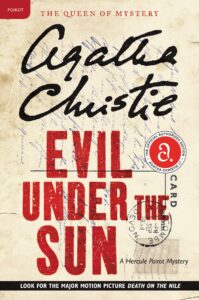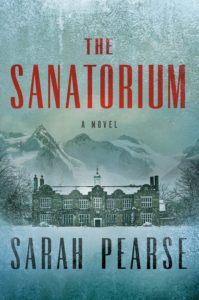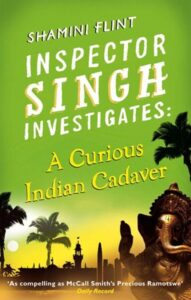In my new Maggie D’arcy mystery, The Drowning Sea, Maggie, a former homicide detective, is trying to relax and take a vacation. She’s out of a job and spending the entire summer on a gorgeous and remote West Cork peninsula, where she and her boyfriend and their children plan to get to know each other and decide if Maggie and her daughter should move to Ireland in the fall. When a body washes up at the base of the cliffs, she’s thrust back into her old line of work.
I’ve always loved the trope of the professional detective who goes on vacation, but is pressed into service when the discovery of a body interrupts the leisurely rhythms of a recreational trip or restorative holiday.
My introduction was through the novels of Agatha Christie and Dorothy L. Sayers. Christie loved to use the set-up of a group of holiday-makers at a bucolic resort and Sayers seemed particularly committed to ensuring that her professional detective, Lord Peter Wimsey, and his eventual wife, detective novelist Harriet Vane, never got to put their feet up and enjoy the feeling of being off duty. In 1931’s Five Red Herrings, Lord Peter is on a fishing holiday when he’s called to the scene of a murder. 1932’s Have His Carcase revisits the same dynamic. Harriet is on a hiking holiday when she discovers the body of the murder victim and has to team up with Lord Peter to solve the case. Rereading Have His Carcase recently, I encountered this favorite line of mine, as Harriet is at the shore and about to discover the body: “There is something about virgin sand which arouses all the worst instincts of the detective-story writer.”
And then, in 1937’s Busman’s Honeymoon, Sayers offered perhaps the ultimate interruption of a vacation for fans of the Wimsey/Vane partnership. At long last, Harriet and Peter are married. The first section of the novel details the arrangements and the event itself through letters and journal entries written by their family and friends. Peter, we learn, has purchased a house near Harriet’s childhood home in Hertfordshire. The house, called Talboys, is supposed to have been readied for their honeymoon.
They arrive, however, to find that the man who sold them the house and who had promised to arrange everything and be there to meet them with the key, is not there. Confusion ensues and Harriet feels immediately responsible. As they work to get Talboys ready for the night, Harriet wonders “Whether, all things considered, Peter would not have been happier in the Hotel Gigantic somewhere-or-other on the continent.”
And in a moment of sparkling insight about the ways we identify with and project on to our partners under the displacing circumstances of travel, Sayers gives us a follow-up scene in which Lord Peter, while clearing out the woodshed so he can shelter his car, stops singing and “wondered whether, after all she might not have been happier at the Hotel Gigantic, somewhere-or-other on the Continent.”
They try to start fires, but the chimneys won’t draw. (I’d forgotten how many pages Sayers devotes to the Talboys chimneys . . .) Bunter, Peter’s long-suffering manservant, manages to make them comfortable. And finally, the wedding night proceeds apace. The next morning, we get a line sure to delight any Sayers devotee: “Lady Peter Wimsey propped herself cautiously on one elbow and contemplated her sleeping lord.”
But the honeymoon doesn’t last long, as the absent former owner of the house is found murdered and Peter must get back to work, playing detective to solve the mystery of his new house.
There has been a recent abundance of thrillers and suspense novels that take place at resorts or while their non-detective characters are on luxury vacations or off-the-grid adventures. There’s so much to be explored about this subgenre-of-a-sort and its examination of class, race, social trust and mobility, influencer culture, and the democratization of travel. In many of the examples of the form I’ve read, a group of characters who only sort of know each other is thrown together at a family reunion, a wedding, or on a weekend trip, creating both real and artificial family dynamics and allowing for an exploration of whether we can trust strangers and how well we really know our friends, family, and co-workers. (Examples are Lucy Foley’s The Guest List, Ruth Ware’s One by One, Jane Harper’s Force of Nature, or Rachel Howzell Hall’s They All Fall Down. I’m really looking forward to Amina Akhtar’s forthcoming novel Kismet, about wellness culture in Sedona, Arizona.) In many of these narratives, the location is the source of the dangers hiding within the group and many nod delightfully to Christie novels like And Then There Were None, but with updated ideas about who gets to go on vacations, who feels safe in those spaces, and who makes those vacations possible.
The pleasures of these novels are slightly different from the buzz of seeing a tired professional detective attempting to recharge. Taking professional detectives and recurring characters from crime fiction series on vacation offers a chance to change the rhythm, I think, for authors to take a breather and delve into other aspects of their subjects’ lives. There are other ways to switch things up for detectives, of course. I deeply appreciate the “Detective on Leave” mystery, where a long-running series character like Michael Connelly’s Hieronymous “Harry” Bosch or Ian Rankin’s Inspector John Rebus is put on leave and steps outside of the daily emergency of crime investigation to take on a cold case or a personal investigation.
Of course, the classic “Detective on Sick Leave” novel is Josephine Tey’s The Daughter of Time, in which her series character, Inspector Alan Grant, is on leave with a broken leg and, in his boredom, takes up a decidedly cold case — the alleged murders of Edward V and Richard Shrewsbury by their uncle, Richard III.
I think what I love most about professional detectives on vacation is the way the trope reveals essential nature and allows the author to explore character against an unfamiliar backdrop. Taken away from everything we associate with them, series characters are shown to be investigators at their very cores. They can’t leave the mystery alone. It is somehow reassuring to know that even without police departments and forensic labs behind them, they will go right on being who they are and doing their jobs, no matter how difficult the circumstances — and no matter how much romantic partners and family members may complain.
Here are a few other classic and contemporary crime novels and stories that feature professional detectives trying their best to relax, but who keep getting pulled back into the detection game.

The Singing Sands by Josephine Tey
Tey’s final novel, discovered after her death and published in 1952, after The Daughter of Time, has Inspector Grant riding a train on his way to visit with old friends in Scotland when a young man dies on the train and Grant accidentally takes a clue away from the scene with him. The novel sensitively delves into Grant’s anxiety and trauma and the need for his getaway, though of course he can’t leave the mystery behind.

Evil Under the Sun by Agatha Christie
Christie frequently took both her professional detective, Hercule Poirot, and her amateur sleuth, Miss Jane Marple, on holidays where murder intervenes. I love all the trappings of 1941’s Evil Under the Sun. Poirot is taking the sun and fresh air at a remote hotel in Devon when the murder of the provocative Arlena Marshall causes him to get out of his beach chair to investigate the motives of the hotel’s many suspicious guests.

Resorting to Murder, ed. By Martin Edwards
This collection, the first in the British Library’s and Poisoned Pen Press’s Classic Crime Collection, contains classic Golden-age mysteries that vex vacationers and sleuths of both the professional and amateur variety.

A Rule Against Murder by Louise Penny
Penny’s famously decent Montreal police detective, Chief Inspector Armand Gamache, is looking forward to his regular week of recharging and relaxing with his wife Reine-Marie at Manoir Bellechasse in Quebec’s eastern townships.
The tensions between members of the Finney family, also vacationing at Manoir Bellechasse, match the rising heat that culminates in a summer thunderstorm. At the end of it, a murder victim is discovered on the grounds and Gamache has to put his romantic break on hold to investigate. I love the atmosphere of this Gamache mystery, the fourth in Penny’s wildly popular series, and the way she deftly characterizes the overburdened, exhausted detective:
“But when he started looking at people in the street and noticing the skull beneath the skin it was time for a break.”

The Sanatorium by Sarah Pearse
The Sanatorium offers another remote setting closed off to the outside world due to a storm. Detective Sergeant Elin Warner is on leave following a traumatic case when she accepts an invitation to celebrate her estranged brother’s engagement at a former sanatorium in the Swiss Alps. She’s supposed to be enjoying the hotel’s amenities, but her own past, the building’s dark history, and the disappearance of her brother’s fiancée make it impossible.

Inspector Singh Investigates: A Curious Indian Cadaver by Shamini Flint
Flint’s Inspector Singh series features a wonderfully put-upon main character, investigating crimes across Asia from his home base in Singapore. In A Curious Indian Cadaver, Singh, on sick leave, attends a family wedding and gets pulled into an investigation.

A Share in Death by Deborah Crombie
Crombie’s series about Scotland Yard Detective Duncan Kincaid and his partner in detecting and eventually in life, Gemma James, was off to an auspicious start in this vacation-ended-too-soon mystery. Kincaid is holidaying in Yorkshire when the discovery of a body at a Yorkshire timeshare forces him back into the fray. He has to negotiate relations with the local investigating authorities as well as his relationship with James.

Hatchet Island by Paul Doiron
Paul Doiron’s Maine Game Warden Investigator Mike Bowditch is supposed to be taking a long-planned sea kayaking vacation with his girlfriend Stacey Stevens. They’ve recently rekindled their relationship and are looking forward to an adventure in the great outdoors. But a series of mysterious events at a research station on a remote island that serves as a seabird refuge drags them into a dangerous investigation.
***


















